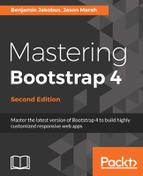Much has changed since Twitter's Bootstrap was first released on August 19th, 2011. In essence, the first version of Bootstrap was a collection of CSS rules offering developers the ability to lay out their website, create forms, buttons, and help with general appearance and site navigation. With respect to these core features, Bootstrap 4 is still much the same as its predecessors—that is, how one uses the framework to create layouts and user interfaces with a consistent appearance. The latter is achieved by applying Bootstrap styles to buttons, forms, and other user interface elements.
While the elementary features of Bootstrap have remained the same, under the hood, the framework has changed completely, as Bootstrap 4 has been rewritten from scratch. As such, the framework introduces new utility classes and new components, and drops support for others at the same time. The appearance of individual components has changed too, and so has the manner in which third-party plugins should be defined and created. The developers of Bootstrap 4 have also stopped support for some older web-browsers and added support for others - namely, Android v5.0 Lollipop’s Browser and WebView. Along with Bootstrap's major features, we will be discussing these changes in the subsections that follow.
